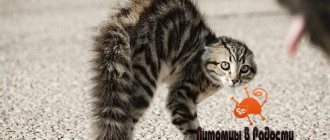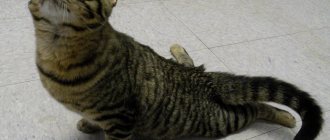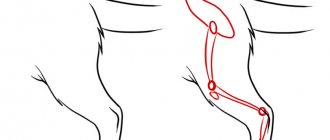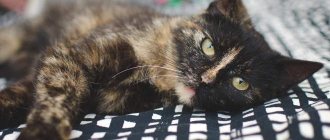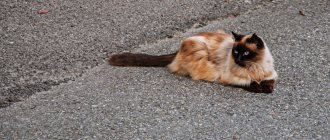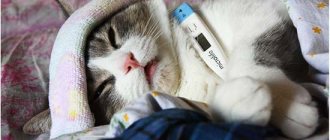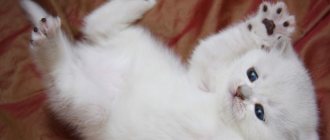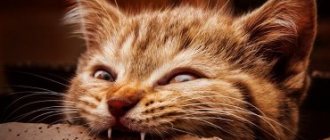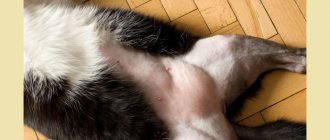If a cat's hind legs fail, this may indicate a traumatic injury, fibrocartilaginous embolism, stroke, spinal hernia, hyperparathyroidism, spinal cord inflammation, thromboembolism, a consequence of a tick bite, vitamin deficiency and metabolic disorders, hip dysplasia, cardiomyopathy. To find out the reason why the paws are failing, the owner should take the cat to the veterinarian. The doctor will diagnose and prescribe treatment.
According to veterinarian statistics, in 21% of cases, arterial thromboembolism with failure of the animal’s hind legs develops against the background of cardiomyopathy.
Reasons why a cat's legs can't walk
Back injury
Spinal injury and pinched nerves occur as a result of a fall from a height, a blow to the back and hind limbs with a heavy object, or a car injury. Most often, the vertebrae of the sacrolumbar region, where the sciatic nerve is located, are damaged. As a result of mechanical action, the bones are displaced and swelling occurs. In addition to the fact that the cat’s hind legs give way and are taken away, the following signs are observed:
- severe pain, especially if the animal moves;
- decreased or absent sensitivity and reflexes of the legs;
- anxiety;
- tachycardia;
- gait disturbance, the cat staggers and drags its paws.
Fibrous cartilaginous embolism
Fibrous cartilaginous embolism develops due to impaired blood supply to the spinal cord structures.
It is rare in cats and is characterized by closure of the spinal cord. Partial or complete cessation of blood supply to the spinal structures leads to cell dysfunction. The etiology of the disease is not clear. Fibrous-cartilaginous embolism begins acutely and suddenly, but the cat does not experience severe pain. The disease causes slight lameness or severe weakness of the hind legs, when the animal cannot stand up. Often the cat does not feel pain in the affected toes. The disease is characterized by uneven changes in the paws: the right side of the body may function worse than the left, and vice versa.
Consequence of stroke
The disease develops as a result of rupture of a vessel or blockage of the lumen by a thrombus. Because of this, the blood supply to the tissues is sharply disrupted and hypoxia occurs. The reason is stress, poisoning of various etiologies, hypertension, cardiovascular and kidney diseases, endocrine disorders, helminthiasis. Symptoms:
- their legs become weak, they don’t listen well, and their legs get twisted;
- coordination is impaired;
- unnatural head tilt;
- inappropriate behavior;
- decreased vision and appetite;
- uncontrolled urination and defecation;
- nystagmus;
- momentary fainting.
Herniated disc
Intervertebral hernia is accompanied by acute back pain and decreased sensitivity of the limbs.
If a cat's hind legs fail, this is a sign of protrusion of the vertebral nucleus and rupture of the fibrous ring. It develops in an old animal, as well as due to injuries, heavy physical exertion, or careless handling of the pet during play. Manifestation:
- severe back pain;
- the legs are very weak, they do not hold, they drag;
- the sensitivity of the hind limbs decreases.
Hyperparathyroidism
If a kitten's hind legs move apart, it cannot walk, drags its legs, collapses and falls, this indicates excessive production of parathyroid hormone by the thyroid gland. The cause is an imbalance of calcium and phosphorus due to improper diet. Paresis and deformation of the legs, impaired urination and defecation, growth retardation, and late change of teeth occur.
Spinal cord inflammation
Limb failure occurs due to spinal damage due to infectious diseases, poisoning, and traumatic back injuries. A pregnant cat that has purulent processes in the uterus can suffer. Signs:
- severe pain syndrome;
- hyperthermia;
- paralysis of the hind legs;
- hyperexcitability;
- licking and biting the back of the body.
Arterial thromboembolism
The formation of a blood clot triggers oxygen starvation, causing the animal to feel severe weakness in the legs.
When a cat stretches its hind legs, does not get up and falls, this indicates a blockage of the arteries with a blood clot. Impaired blood flow leads to oxygen starvation of tissues, which causes the cat's legs to hurt and collapse. The pathology occurs against the background of blood clotting disorders, neoplasms, decreased permeability of vascular walls, heart disease, and poisoning. Signs:
- changes in gait and the appearance of lameness;
- legs are cold and pale;
- severe muscle tension and soreness.
Tick bite
If one leg does not walk, the animal often squats, or the cat is paralyzed, this is a manifestation of an ixodid tick bite and the development of tick-borne encephalitis. In addition to the fact that the front or rear legs do not move, the disease is manifested by refusal of food, difficulty breathing, pallor of the mucous membranes, apathy, convulsions, changes in behavior and loss of coordination of movements.
Vitamin deficiency and potassium metabolism disorders
If a cat crouches and drags its hind paw when walking, this is a manifestation of a lack of vitamins B and D, which are necessary to strengthen bones, nerves, and muscle tissue. Potassium is needed for the transmission of nerve impulses, improving the functioning of the heart and kidneys. Veterinarians associate the etiology of vitamin deficiency and potassium deficiency with poor nutrition when the cat is malnourished or has helminths.
Hip dysplasia
The congenital disease leads to curvature of the pelvis, and in old age cats experience muscle weakness.
It is considered a congenital feline disease in which kittens are born with underdeveloped hip joints. In cats, due to weak ligaments, the paw does not function well, it drifts to the side when moving, and later paralysis, curvature of the pelvis, arthrosis of the hip joint, and habitual dislocation develop. An old cat develops muscle weakness, she is unable to lift her legs, drags them, and refuses to jump.
Cardiomyopathy
It is characterized by thickening of the walls and muscles of the heart, as a result of which the blood supply to all organs deteriorates. Often, against the background of cardiomyopathy, blood clots form that clog the blood vessels. Thromboembolism develops, due to which the hind limbs suffer and the cat falls on its hind paw.
How to help a cat with sore paws
As you may have noticed, the symptoms are very similar, while the reasons that caused them are varied. Based on this, treatment is selected individually in each specific case. This is why there are professionals who can correctly diagnose and decide what to do next.
Therefore, as soon as you notice something is wrong, immediately call the veterinary clinic, where specialists will examine the cat, take tests and prescribe treatment. In addition to the course of therapy, our doctors will definitely give recommendations on caring for the animal. Don’t delay your visit, many ailments can be successfully treated in the early stages, contact us at the veterinary center. Veterinarians at the Belaya Medveditsa clinic work 24 hours a day, call at any time.
POLAR BEAR
The veterinary clinic in Nizhny Novgorod "White Bear" provides all types of services for cats and dogs.
Conducts any examinations and tests in its own veterinary laboratory; the clinic operates a veterinary ambulance for animals and a 24-hour veterinarian is on call at home. Agreement on the processing of personal data
Public offer
SITE MENU
- About the clinic
- Price list for veterinary clinic services
- Treatment
- Services
- Price list for veterinary clinic services
- Vetapteka
- Contacts
- Site Map
CONTACTS
- Nizhny Novgorod st. Vyatskaya 7
- 8 (831) 437-25-27
- [email protected]
What to do if a cat loses its paws?
Therapy is prescribed by a veterinarian individually. For injuries and thromboembolism, surgical intervention is performed. Symptomatic treatment and antibiotics alleviate the condition of a stroke or after a tick bite. In case of a herniated spine, the protrusion is removed and the displaced structures are put in place. You should massage the cat's hind legs - stroking, flexing and extending the legs, kneading. Hyperparathyroidism is treated with calcium supplements, and for vitamin deficiency, a balanced diet is prescribed.
Signs of limb failure
You can notice a cut or paralysis of the limbs in your pet based on various obvious signs. The most striking thing is that the pet slightly pulls one or both paws behind it, and the gait also becomes not as confident as that of a healthy animal, and painful sensations arise when leaning on the paws. It is very important to take a close look at your pet's behavior. The main signs of paralysis include the following:
- The gait becomes very unsteady, affecting mainly the back of the body.
- The animal is not able to maintain normal balance, and performs all movements somewhat slowly.
- There is a slight weakness in the cat's hind legs, which later develops into complete muscle failure.
- The animal can very often sit on the back. Most often, this behavior can be observed in old animals.
- The cat moves by dragging its paws behind it and without lifting them off the floor.
- In general, the animal’s mobility is noticeably reduced.
All of the above reasons are a warning sign that the animal may have problems with the musculoskeletal system. Delay in treatment or self-medication can lead to very serious consequences, so it is very important to consult a specialist in a timely manner.
Therapy methods
As mentioned above, it is very important to consult a specialist in a timely manner to understand the cause of the cat’s lameness and begin treatment. There are a large number of different causes that can lead to lameness and complete failure of the hind legs. It is impossible to identify these causes on your own and without specialized equipment; in this case, you will simply waste precious time, missing the opportunity for a complete recovery.
When you contact a veterinary clinic, therapy involves the following methods:
- neurological examination of the animal;
- conducting an X-ray examination to identify problems of the spinal column;
- ultrasound examination of the abdominal cavity and organs located in this area;
- if the veterinarian suspects that the animal has some kind of infection, then a special test is carried out to identify any bacteria;
- A biochemical analysis of blood and urine is taken.
Once the cause contributing to the failure of the hind limbs is established, special therapy is prescribed. If the animal has suffered a serious injury resulting in damage to the spine, immediate surgical intervention is required.
If the reason for the failure of the hind legs is a fall from a great height, then the doctor may prescribe Milgama or Metipred. It is also very important to undergo various physical procedures that will help in a speedy recovery. During the inflammatory process, the behavior of nerve impulses in the hind legs is disrupted, so animals are often given a massage using alcohol and camphor oil. With such injuries, the owner must constantly turn the animal over so that it does not develop bedsores. Basically, with such injuries, spontaneous defecation does not occur, so it is very important to help the animal clear its intestines in a timely manner.
If the doctor diagnoses thromboembolism, and there are no obvious signs of necrosis, then anticoagulants are prescribed. Only specialists can prescribe such drugs, since internal bleeding can occur if the dosage is incorrect.
Call a veterinarian Moscow
+7(495)162-70-70
If the paralysis of the cat’s hind legs was caused by the most common vitamin deficiency, then there is no need to worry at all, because the treatment is quite simple. In this case, it is necessary to review the cat’s diet so that it receives sufficient amounts of vitamins A and B.
Dysplasia is very difficult to treat and requires the application of a special bandage. The animal is also prescribed special anti-inflammatory drugs and glucosamine with chondroetin. There are cases when dysplasia requires surgical intervention.
Pinched sciatic nerve
Cats are constantly in motion, jumping somewhere, climbing somewhere, and this often provokes pinching of the sciatic nerve. It would seem to be a simple disease that is quite easy to diagnose, but it is not. When pinched, cats feel well, their behavior remains unchanged. They have a good appetite and play willingly, but just during physical activity their hind legs begin to hurt. They begin to tug at them and sit on their sides, while licking them.
During pinching, dislocations and similar problems, in addition to general therapy prescribed by a veterinarian, massages must be done at home. If the paws are still paralyzed, in order to avoid atrophy of the muscles with the cat, you need to regularly do gymnastics, carry out water treatments, exercise on a ball (roll the ball back and forth), and also stroke the limbs with light circular movements. Thanks to such simple manipulations, your furry friend will recover faster.
Symptoms of joint damage
The first thing you will notice when a cat develops arthritis or arthrosis is behavioral changes. If before the pet loved to run, jump and play, now he takes care of his paw and avoids stress. At stages II and III of the disease, the animal experiences pain even when moving short distances (for example, from one room to another).
The main symptoms of arthritis and arthrosis in cats:
- Soreness . It is observed in the affected area, while the pet becomes angry if someone tries to touch it, and meows loudly;
- Stiffness . The animal loses motor activity and rests more often. Begins to walk slowly and limp;
- Edema . There is swelling in the problem area. The cat's body temperature rises, especially with severe pain;
- Crunch . Due to the destruction of the layer between the cartilages, strong friction of the bones occurs, so when the cat moves, a specific crunching sound (rough, dry clicking) may be observed.
Note! Arthritis and arthrosis negatively affect the appearance of the pet. Because of the pain, he practically stops caring for his fur: it becomes dirty and gets tangled.
Diagnosis of lameness
For the owner, any change in habitual behavior can be a reason to closely monitor the pet. We tend to think that lameness is easy to notice, but cats are special animals and this is not true for them. A limping cat can masterfully transfer its body weight to healthy limbs, and outwardly its movement will remain virtually unchanged. Therefore, the first signs of lameness can be considered changes in the cat’s activity:
- decreased activity, the cat sleeps more and plays less;
- lack of jumping activity, if they were there before;
- searching for shelter, a secluded place, previously not typical for a cat;
- deterioration in the condition of the coat due to difficulties with self-grooming - due to a sore paw or the inability to turn around, the cat may have difficulty grooming its coat.
In chronic pathologies, such symptoms can increase gradually, as a result of which the owner seems to think that everything is normal, sometimes this is associated with age-related changes. However, despite the seeming harmlessness, this is a reason to take your cat to the doctor and make sure that he is not in pain for any reason. If you see that your cat is limping, dragging its paws, placing them incorrectly, has an unsteady gait, or tremor (trembling) of its limbs, this is a reason to urgently consult a veterinarian.
The primary diagnosis of lameness consists of a physical examination by a doctor, taking a medical history, and conducting an orthopedic or neurological examination. Further diagnosis will depend on the results of the examination.
